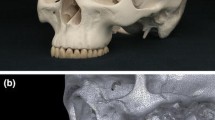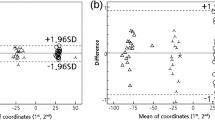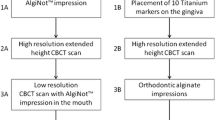Abstract
This study proposes a method that integrates maxillary dental cast and cephalograms and evaluates its accuracy compared with cone-beam computed tomography (CBCT) scans. The study sample comprised 20 adult patients with records of dental casts, cephalograms, and craniofacial CBCT scans. The maxillary dental cast was integrated with lateral and frontal cephalograms based on best-fit registration of palatal and dental outline curves from dental cast with cephalogram tracings. Linear measurement was conducted to assess the intra- and inter-examiner reproducibility of the proposed integration method using intraclass correlation coefficients; linear and angular measurements were conducted to assess its accuracy with CBCT scans as a standard reference. Paired t test, one sample t test, and mean ± standard deviation of the absolute value of difference were used to compare the integrated images and CBCT. The integration method showed good intra- and inter-examiner reproducibility (intraclass correlation coefficients > 0.98). The differences in linear and angular measurements between the integrated images and CBCT were not statistically significant but with a large deviation. When absolute value of difference was computed, the linear distance error was 0.51 ± 0.34 mm, the tooth point coordinate errors in X, Y and Z axes were 0.22 ± 0.22, 0.38 ± 0.32 and 0.21 ± 0.21 mm, respectively; the angular error in pitch, roll and yaw of the dental cast was 0.82 ± 0.51, 0.92 ± 0.59 and 0.80 ± 0.41 degree, respectively. The proposed method for integration of dental cast and cephalograms showed good reproducibility and acceptable accuracy compared with CBCT. It could be helpful for researchers to study three-dimensional tooth growth changes using the existing craniofacial growth data especially cephalograms.





Similar content being viewed by others
Availability of data and materials
The datasets used and analyzed during the current study are available from the corresponding author on reasonable request.
Abbreviations
- CBCT:
-
Cone-beam computed tomography
- 3D:
-
Three dimensional
- 2D:
-
Two dimensional
- N:
-
Nasion
- ANS:
-
Anterior nasal spine
- PNS:
-
Posterior nasal spine
- UMR :
-
Mesiobuccal cusp of right second molar
- UML :
-
Mesiobuccal cusp of left second molar
- UIR :
-
Midpoint of the incisal edge of the right central incisor
- ICC:
-
Intraclass correlation coefficients
References
Bjork A, Skieller V. Facial development and tooth eruption. An implant study at the age of puberty. Am J Orthod. 1972;62:339–83.
Bjork A, Skeller V. Postnatal growth and development of the maxillary complex. In: McNamara JA, editor. Factors affecting the growth of the midface, monograph 6, craniofacial growth series. Ann Arbor: Center for Human Growth and Development, University of Michigan; 1976. p. 61–9.
Iseri H, Solow B. Continued eruption of maxillary incisors and first molars in girls from 9 to 25 years, studied by the implant method. Eur J Orthod. 1996;18:245–56.
Nielsen IL. Maxillary superimposition: a comparison of three methods for cephalometric evaluation of growth and treatment change. Am J Orthod Dentofacial Orthop. 1989;95:422–31.
Baumrind S, Ben-Bassat Y, Bravo LA, Curry S, Korn EL. Partitioning the components of maxillary tooth displacement by the comparison of data from three cephalometric superimpositions. Angle Orthod. 1996;66:111–24.
Tsourakis AK, Johnston LE. Class II malocclusion: the aftermath of a “perfect storm.” Semin Orthod. 2014;20:59–73.
Martinelli FL, de Oliveira Ruellas AC, de Lima EM, Bolognese AM. Natural changes of the maxillary first molars in adolescents with skeletal class II malocclusion. Am J Orthod Dentofacial Orthop. 2010;137:775–81.
Marshall S, Dawson D, Southard KA, Lee AN, Casko JS, Southard TE. Transverse molar movements during growth. Am J Orthod Dentofacial Orthop. 2003;124:615–24.
Hesby RM, Marshall SD, Dawson DV, Southard KA, Casko JS, Franciscus RG, et al. Transverse skeletal and dentoalveolar changes during growth. Am J Orthod Dentofacial Orthop. 2006;130:721–31.
Alessandri-Bonetti G, Incerti-Parenti S, Garulli G, Gatto MR, Visconti L, Paganelli C. Maxillary first premolar inclination in 8- to 11-year-old children: an observational cross-sectional study on panoramic radiographs. Am J Orthod Dentofacial Orthop. 2016;149:657–65.
Yatabe M, Prieto JC, Styner M, Zhu H, Ruellas AC, Paniagua B, et al. 3D superimposition of craniofacial imaging—the utility of multicentre collaborations. Orthod Craniofac Res. 2019;22(Suppl 1):213–20.
Jang I, Tanaka M, Koga Y, Iijima S, Yozgatian JH, Cha BK, et al. A novel method for the assessment of three-dimensional tooth movement during orthodontic treatment. Angle Orthod. 2009;79:447–53.
Chen G, Chen S, Zhang XY, Jiang RP, Liu Y, Shi FH, et al. Stable region for maxillary dental cast superimposition in adults, studied with the aid of stable miniscrews. Orthod Craniofac Res. 2011;14:70–9.
Park TJ, Lee SH, Lee KS. A method for mandibular dental arch superimposition using 3D cone beam CT and orthodontic 3D digital model. Korean J Orthod. 2012;42:169–81.
Christou P, Kiliaridis S. Vertical growth-related changes in the positions of palatal rugae and maxillary incisors. Am J Orthod Dentofacial Orthop. 2008;133:81–6.
Curry S, Baumrind S, Carlson S, Beers A, Boyd R. Integrated three-dimensional ciraniofacial mapping at the craniofacial research instrumentation laboratory/university of the Pacific. Semin Orthod. 2001;7:258–65.
Baumrind S, Carlson S, Beers A, Curry S, Norris K, Boyd RL. Using three-dimensional imaging to assess treatment outcomes in orthodontics: a progress report from the university of the Pacific. Orthod Craniofac Res. 2003;6(Suppl 1):132–42.
Hans MG, Palomo JM, Dean D, Banu C, Min KJ, Han S, et al. Three-dimensional imaging: the case western reserve university method. Semin Orthod. 2001;7:233–43.
Kim HJ, Kim BC, Kim JG, Zhengguo P, Kang SH, Lee SH. Construction and validation of the midsagittal reference plane based on the skull base symmetry for three-dimensional cephalometric craniofacial analysis. J Craniofac Surg. 2014;25:338–42.
Ackerman JL, Proffit WR, Sarver DM, Ackerman MB, Kean MR. Pitch, roll, and yaw: describing the spatial orientation of dentofacial traits. Am J Orthod Dentofacial Orthop. 2007;131:305–10.
Almeida MA, Phillips C, Kula K, Tulloch C. Stability of the palatal rugae as landmarks for analysis of dental casts. Angle Orthod. 1995;65:43–8.
Hoggan BR, Sadowsky C. The use of palatal rugae for the assessment of anteroposterior tooth movements. Am J Orthod Dentofacial Orthop. 2001;119:482–8.
Kim HK, Moon SC, Lee SJ, Park YS. Three-dimensional biometric study of palatine rugae in children with a mixed-model analysis: a 9-year longitudinal study. Am J Orthod Dentofacial Orthop. 2012;141:590–7.
Kim HJ, Yun HS, Park HD, Kim DH, Park YC. Soft-tissue and cortical-bone thickness at orthodontic implant sites. Am J Orthod Dentofacial Orthop. 2006;130:177–82.
Pittayapat P, Bornstein MM, Imada TSN, Coucke W, Lambrichts I, Jacobs R. Accuracy of linear measurements using three imaging modalities: two lateral cephalograms and one 3D model from CBCT data. Europ J Orthod. 2015;37:202–8.
Sam A, Currie K, Oh H, Flores-Mir C, Lagravere-Vich M. Reliability of different three-dimensional cephalometric landmarks in cone-beam computed tomography: a systematic review. Angle Orthod. 2019;89:317–32.
Noh H, Nabha W, Cho JH, Hwang HS. Registration accuracy in the integration of laser-scanned dental images into maxillofacial cone-beam computed tomography images. Am J Orthod Dentofacial Orthop. 2011;140:585–91.
Sun LJ, Hwang HS, Lee KM. Registration area and accuracy when integrating laser-scanned and maxillofacial cone-beam computed tomography images. Am J Orthod Dentofacial Orthop. 2018;153:355–61.
Acknowledgements
We thank M.C. Yu (Center of Information Science, School of Electronics Engineering and Computer Science, Peking University) for MATLAB programming.
Funding
This work was supported by the International Science & Technology Cooperation Program of China (grant No. 2014DFA31800), National Nature Science Foundation of China (grant No. 82071172, 51972005, 51672009), Beijing Natural Science Foundation (grant No. 7192227) and Beijing Municipal Science and Technology Commission (No. Z181100001718112) in the design of the study and collection, analysis, and interpretation of the data and in writing the manuscript.
Author information
Authors and Affiliations
Contributions
BH and TX designed the experiments. JJ, RJ and JL provided the sample. FD and TF executed the experiments. FD and WL analyzed the data and wrote the manuscript. SC and GC made critical revision. All the authors read and approved the final manuscript.
Corresponding authors
Ethics declarations
Conflict of interest
The authors declare that they have no competing interests.
Ethical approval
This study was approved by the Ethics Committee of the Peking University School and Hospital of Stomatology (PKUSSIRB-201626009).
Informed consent
Written informed consent was obtained from all the patients involved in the study.
Consent for publication
Not applicable.
Additional information
Publisher's Note
Springer Nature remains neutral with regard to jurisdictional claims in published maps and institutional affiliations.
Supplementary Information
Below is the link to the electronic supplementary material.
Rights and permissions
Springer Nature or its licensor holds exclusive rights to this article under a publishing agreement with the author(s) or other rightsholder(s); author self-archiving of the accepted manuscript version of this article is solely governed by the terms of such publishing agreement and applicable law.
About this article
Cite this article
Dai, F., Chen, S., Feng, T. et al. Accuracy of integration of dental cast and cephalograms compared with cone-beam computed tomography: a comparative study. Odontology 111, 238–247 (2023). https://doi.org/10.1007/s10266-022-00732-6
Received:
Accepted:
Published:
Issue Date:
DOI: https://doi.org/10.1007/s10266-022-00732-6




